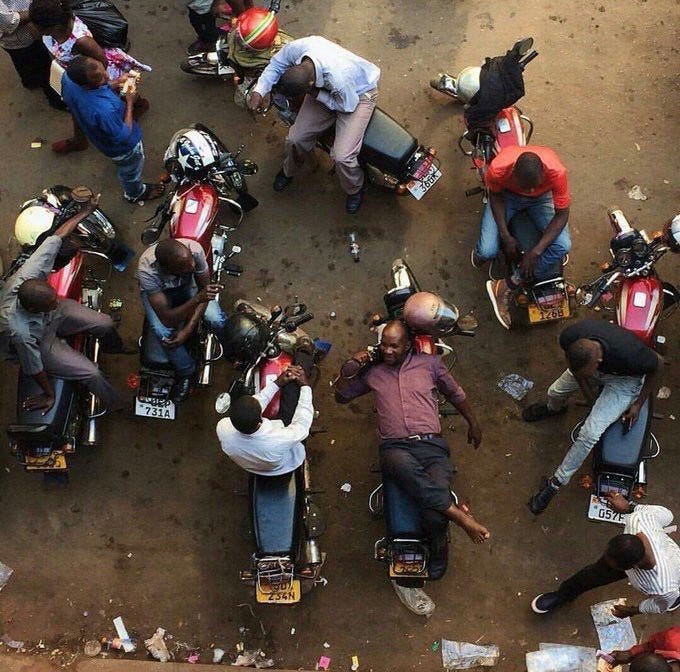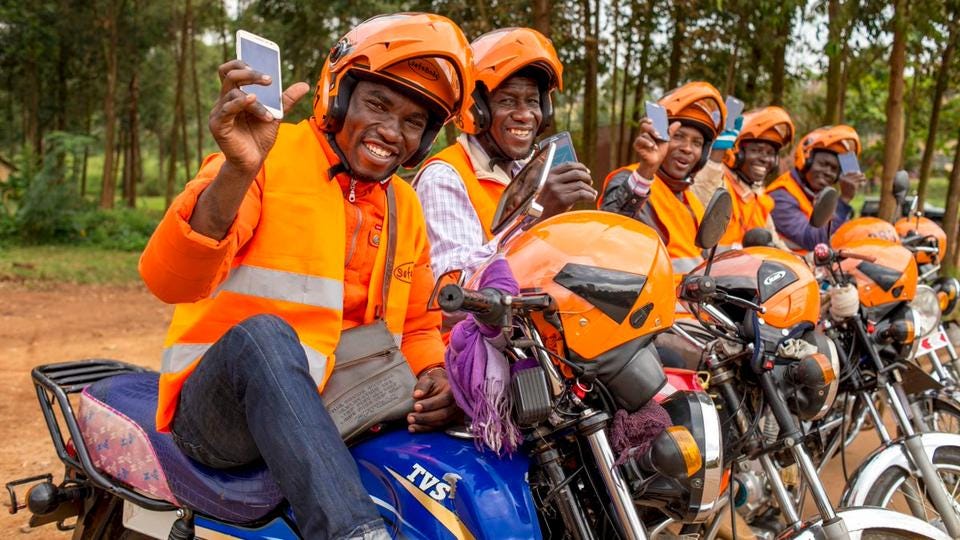#28 It takes two to tango
The rise of two-wheelers in Africa
Hey friend,
Here’s your fortnightly dose of Makeshift Mobility, your first newsletter focused on innovations in informal transportation. Happy Easter to those of you who observe it!
Did you miss me?
I missed me. But, I was glad for the day of rest.
Interestingly enough, my letter to you two weeks ago had one of the highest open rates ever. I guess the title “taking a break” was arresting.
A friend said that maybe I should exercise in clickbait subject lines to get the same open rates. I considered using “UFOs abduct boda bodas, plan to secretly conquer cities with alien motorcycles.”
You wouldn’t fall for that, would you? Would you?
I know newsletters seem to be the information channel du jour but they’ve been around for quite a while. WIRED says peak newsletter was in the 1940s. Clickbait is also over a century old.
FYI, my undergrad is in journalism so in a way this newsletter returns me to my roots, before I fell in-love with cities and became a transportation geek.
Border to border
I’ve been diving into the world of motorcycle taxis in Africa.
It’s hard to find current numbers for the total numbers across the continent but this article from the Water Channel, proposing creating 500K jobs through motorcycle taxis in Ethiopia, cites impressive numbers from several countries:
In Tanzania the number of motorcycles has increased from 2000 in 2003 to more than 800,000 in 2014 after restriction on importing motorbikes were lifted (Starkey, 2016). It is estimated that in a country of 56 Million, this has created over 500,000 jobs for young men operating motorbike taxis.
In Uganda the motorbike business has expanded so much that it may now be the second largest source of employment after agriculture. 7% of Uganda’s population depends on this industry. Majority of these are men between the ages of 25-29 years (Turyahikayo & Ayesigye, 2017).
Motorcycle taxis contribute to more than 75% of annual passenger transport and small freight on rural roads in Ghana, Malawi, Mozambique, Sierra Leone (Starkey, 2016, Unescap, 2005).
On a rural road surveyed in Cameroon, 82% of passenger movements a year were on motorcycles, as well as 74% of the produce and goods going to and from markets (Starkey & Hine, 2014).
The same article answers the question, “How many motorbikes are there in Kenya?”
In 2007, an estimated 100,000 motorbikes were registered. In September 2016, the number reached over 700,000 and the number is still growing. Probably 450,000 of the motor bikes are used as motorbike taxis. Since a boda-boda is often used by more than one rider, the number of driver jobs created is even higher. By now there are 21 assemblers in Kenya. Furthermore, there is considerable employment from repair shops and driving schools.
Daniel Mwesiga, who is a fellow at the Berkman Klein Center for Internet & Society at Harvard University, has a brilliant (though, IMHO, a bit verbose) piece on the boda boda political economy. He tells us about the impact these two-wheelers have had on the economy of Kenya.
The ubiquity of boda bodas and mobiles (phones) marked the turn of the last decade in (Sub Saharan Africa). For example, both have enabled last-mile communication and integrated hard-to-reach places such as rural areas into the main economy. For context, in 2017, the boda boda sector in Kenya generated KES 219 billion (USD 2.1 billion) in revenue i.e KES 7 billion (USD 70 million) more than Safaricom’s consolidated revenues for that year — Safaricom’s flagship M-Pesa generated KES 62.9 billion (USD 629 million) — signalling the boda sector’s importance in Kenya’s economy and identity.
More from Daniel’s piece later, but whatever the continent-wide number and growth rate is, it is impressive enough for a stampede of startups.
Name to name
Tom Courtright created and tweeted this map of names for motorcycle taxis in Africa.
The etymologies of the names would be fascinating to study just by itself.
You already know that boda boda comes from “border to border” which is where these bike (pedal and motor) taxis started in East Africa.
Okada apparently comes from the name of a defunct Nigerian airline. (Wouldn’t you like to know how that happened?)
Why are they called jakartas in Senegal and does the name have anything to do with the ojeks of the Indonesian capital?
Tom’s map recalls Funmi Oyatagun’s map of names for matatus which I featured in the second issue of Makeshift Mobility.
We so need these kinds of maps. We so need to gather this kind of knowledge.
Knowledge to knowledge
That’s one of the ambitions of the Global Partnership for Informal Transportation, which I co-chair. We’re hoping to build the Global Encyclopedia of Informal Transportation Vehicles.
We think that mapping the names and getting information will help us understand the global scale of informal transportation. It will also be foundational for understanding and encouraging innovations we need in the space.
Stage to stage
Tom Courtright and Geofrey Ndhogezi co-author Lubyanza, which…
…is the product of conversations between Tom Courtright and Geofrey Ndhogezi — a student of urban planning and a boda rider — about bodabodas and their roles in the social fabric of Kampala. Together, Geofrey and Tom have investigated the impact of electric motorcycles, the habits and behaviors of boda riders, the history of Kampala and the role of bodabodas in city and national politics.
Geofrey tells us what lubyanza means and why it’s his nickname:
Boda riders basically operate at stages, like bus stops, where they park as they wait for passengers. However, some boda riders choose not to belong to any stage so they keep riding, picking and dropping passengers until they go home. Every such rider is locally called lubyanza. Because I worked the lubyanza-style for too long, everyone called me Lubyanza even when I got a stage.
I’ve learned a lot from their blog so I suggest following them on Medium.
Tom’s latest post (the first of two parts) is all about the history of stages.
Moving around Kampala and all across towns in Uganda, groups of boda riders are hanging out next to shops, intersections, and wide spots in the road. Often in groups of five to fifteen riders, these are boda stages — places riders can rest and tell stories, as well as pick up and let off passengers.
It’s a fascinating, first-person (from Geofrey’s experience) account of how informal transportation self-organizes. They show the role of social trust, convenience, political power, policing, and corruption in shaping informal transportation.

Returning to Daniel’s piece, here’s what he says about stages:
Bodas in Uganda are highly localized and operate at bases known as “stages”. Stages are closer to the concept of the “mobile money agent” than they are to the terminus. While these stages are constrained by geography, it does not mean that a boda cannot move about to any part freely. In fact, since the city is small, with a 10Km radius, bodas can easily navigate from one stage in the suburbia through the cacophony of traffic in the city centre to another suburb.
Stage guys often position themselves as loyal and trustworthy. In that way, they cultivate meaningful relationships with people who live within their milieux for a particular set of purposes such as dropping/picking kids from school and running a different set of home errands.
Meanwhile, it’s important to note the security dimension of bodas in the political economy; they are also efficient para-intelligence tools. Just like mobile phones, boda have enabled as much intelligence gathering in the most unlikely of places. They have surreptitiously found ways to situate themselves to assess what is happening, to watch others and whom they deal with, and to listen to their conversations, without necessarily constituting a threat.
Power to power
Tom and Geofrey also introduced me to the rise and fall of Boda Boda 2010, ostensibly a boda boda drivers group which eventually became an instrument of intimidation in Kampala.
If you’ve been having libertarian fantasies that informal transportation simply needs to be freed from state regulations and it will bloom and give our cities better mobility, groups like Boda Boda 2010 should give you pause.
Unless there are community driven guide rails, the self-organization inherent in informal transportation can very frequently metastasize into corruption and, as Daniel hints, and the Boda Boda 2010 experience shows, easily become state instruments of oppression.
Market to market
Daniel links to Marcheti’s Motorcyles, an expansive post on motorcycle taxis by Osarumen Osamuyi. Osarumen opens with:
How do you think about motorcycle taxi hailing in Africa? If you were like me three years ago, you mostly didn't — it hadn't become one of the sectors du jour, and our collective love affair with fintech had only just begun. But from 2017 through '18, pockets of activity started to show up on the continent: MAX, originally an on-demand logistics service from Nigeria, announced MAXGo in mid-2017; its main competitor, Gokada, would launch seven months after. 3000+ kilometers away in Uganda, SafeBoda overhauled their technology and kicked off international expansion the following year. With backing from the Rwandese government, Yegomoto started rolling out their taximeters to Kigali's 15,000+ motorcycle taxi drivers, while global players like Uber and Bolt/Taxify joined the fray with their boda boda offerings in Kampala and Nairobi.
These startups present their products in ways that reflect the cultures and assumed customer needs in their countries of origin. East African players, for example, generally threaten to bring safety and sanity to a boda industry mired in chaos (see: Uganda's "Safe"-Boda and Rwanda's "Safe"-Motos), while their counterparts from West Africa mostly market themselves as the fastest means of transport in congested cities (see: MAX-"Go", "Go"-kada from Nigeria and "Go"-zem from Togo).
Regardless of their positioning, though, the playbook seems pretty obvious:
Step 1: Offer transportation as a service and grow as quickly as the market permits — just like Grab and Go-Jek in Southeast Asia
Step 2: Leverage scale to layer on adjacent services like identity, mobile payments, credit, micro-insurance, etc — just like Grab and Go-Jek in Southeast Asia
Step 3: Extend services beyond core use case, expand into new verticals, and build ecosystems around your platform — just like Grab and Go-Jek in Southeast Asia
Step 4: $-$-$-$-$ — just like Grab and Go-Jek in Southeast Asia
Model to model
Both Daniel’s and Osarumen’s articles serve a lot to digest (and comment on) but I leave you with this one takeaway from Marchetti’s Motorcycles on the two go-to-market philosophies currently animating the entry of tech into motorcycle taxis:
The demand-centric model says the locus of power is the commuter — just like it is with services like Uber. In other words, the company that aggregates the most users [demand] will incentivize drivers to ride for it and thus, create liquidity for itself through abundance. Here, the business model is obvious: take a cut of the rider fares in exchange for access to the platform. The most obvious risk they contend with is promiscuity: I frequently hail UberBodas in Nairobi, and get picked up by drivers wearing SafeBoda helmets, Taxify reflector vests, and so on. On the other hand...
The supply-centric model says the driver is the locus of power. Here, companies create their own liquidity through scarcity — recruiting drivers as quickly as they can, locking them into asset financing contracts, and precluding competitors from accessing them. This means that for the duration of the agreements (and likely long afterwards), the drivers wear their branded gear, paint their motorcycles in their colors, use their apps, etc. The most obvious risk is reputational - the platform pays handsomely in brand equity for their drivers' bad behavior, but it's also more difficult to scale: imagine Uber had to help each driver buy a car.
Very interesting.
How we use those go-to-market philosophies to improve makeshift mobility for the driver and the commuter is the rub.
Power to power, redux
I leave you on an up note.
Bloomberg tell us that electric motorcycle taxis have also hit the ground and are looking to gain market share.
Most of the motorbikes on East Africa’s roads are cheap petrol bikes, usually imported from India or China in parts before they’re assembled, with noisy engines and high repair costs which drain drivers’ income. Electric bikes, on the other hand, are much quieter, have lower repair costs, and can have their batteries replaced in just a few minutes.
“Ever since I started driving an electric bike, I’ve had more money to bring home gifts for my children,” said Thacien Mbuzehoze, the first driver to buy a bike on a rent-to-own basis from Ampersand when it launched commercially last year. “Other drivers thought it was a gimmick. Over time, once I made more money, other drivers started approaching me to ask how I got it.”
Ok. That’s it for this issue. Leave me a comment and share if you enjoy.
Catch you again in two weeks.
I’m Benjie de la Peña and I’m the CEO of the Shared-Use Mobility Center. I co-founded Agile City Partners, and I am the Chair of the Global Partnership for Informal Transportation.
I ride around in an electric tandem bike but I’d like to ride an electric boda boda or okada.
I’m convinced that informal transportation can be the single greatest lever to decarbonize the urban transport sector, but only if we stop ignoring it and instead learn to celebrate it so we can transform it.






Great piece! Thanks
Great article! I've heard a lot about safety issues with motorcycle taxis (and with motorcycles in general). You allude to some of them, but I'd love to hear more.